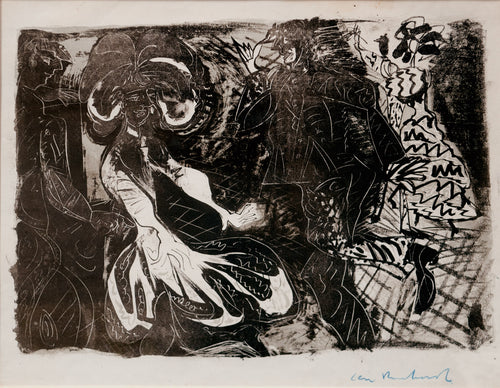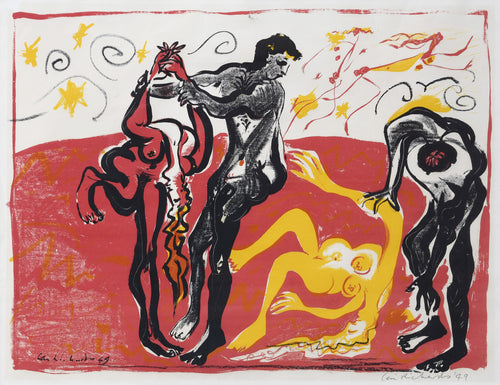
In the contorted composition of Ceri Richards’ Lion Hunt paintings, the major theme of his later work – the violent beauty of the natural world – was brought into sharp focus.
A Welsh artist whose reputation has for years been unfairly overlooked in favour of contemporaries Francis Bacon and Graham Sutherland, Richards was nonetheless one of Britain’s most talented 20th century artists. His eclectic range of work, which drew upon his early days as a Surrealist, the abstract experimentation of the pre and post-war period, and his lifelong love of poetry and music, defied straightforward classification by critics, undoubtedly to the detriment of his status in the art world.
Throughout the latter half of his career, Richards returned frequently to the idea of new ‘versions’ of paintings, improvising on and reinventing the compositions of former masters (a process he had inherited from his idol Picasso). In the Lion Hunt series of canvases, Richards looked back to Delacroix’s famed La Chasse aux lions, itself a reinterpretation of a painting by Rubens. Self-consciously adapting an image that was itself a ‘version’ (and of which Delacroix had made numerous variations), Richards was reinvigorating a longstanding tradition in European painting that traced its roots to the Renaissance and beyond.
 Ceri Richards' 'Lion Hunt', based on an original painting by Eugène Delacroix
Ceri Richards' 'Lion Hunt', based on an original painting by Eugène Delacroix
In Richards’ new version, first begun in 1962, the busy brutality of Delacroix’s original is further confused as the forms of writhing lions and horseback hunters are blurred and blended together. To the left, a lion rears its twisted head towards a plunging sword, the crumpled body of a hunter held beneath its claws; to the right, a second lion savages a fellow hunter’s mount, its gnarled head and shoulders near indiscernible from intertwined prey.
As the critic Mel Gooding wrote in his monograph on the artist, Richards’ masterful reinvention of the original material put the emphasis on the cyclical nature of the hunt, in which man and beast become emblematic of life and death: For all its potential as a subject for virtuosic variations, it was, of course, ‘the ferocity of the subject’ that had captured his imagination: the ‘Lion Hunt’ paintings are essentially workings of the perennial Richards theme of the perpetual dynamism and violence of the natural world.

 (above) lower detail from 'Lion Hunt', showing a second horse wrestled to the ground by an indistinct lion; (below) original exhibition labels from Fischer Fine Art Ltd.
(above) lower detail from 'Lion Hunt', showing a second horse wrestled to the ground by an indistinct lion; (below) original exhibition labels from Fischer Fine Art Ltd.
In its twisting tumult of a composition, all motion made more giddy by the vivid tones of vermillion blood and sapphire-blue cloth, Richards’ Lion Hunt represents the artist at the peak of innovation, befitting his nickname amongst contemporaries as the true ‘painter’s painter’.










